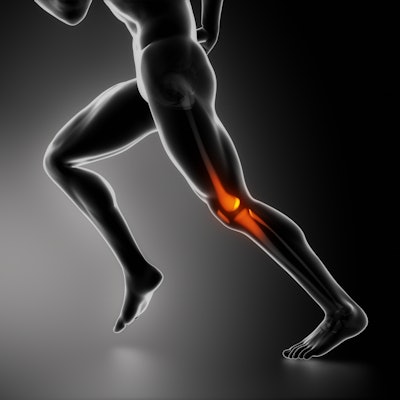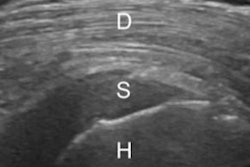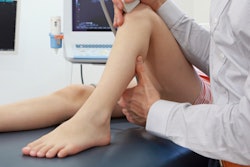
Radiologists had a market share of less than 40% for musculoskeletal (MSK) ultrasound exams in the U.S. in 2015, down from 65% in 2003, indicating they could be losing control of the modality, according to a study published online December 13 in the Journal of the American College of Radiology.
 Dr. Riti Kanesa-thasan from Thomas Jefferson University.
Dr. Riti Kanesa-thasan from Thomas Jefferson University.Although radiologists still have an important place in MSK imaging -- their share of musculoskeletal MRI remains stable, at 93% -- it's important to keep the big picture in mind, especially in a changing reimbursement environment, said lead study author Dr. Riti Kanesa-thasan from the Center for Research on Utilization of Imaging Services (CRUISE) at Thomas Jefferson University.
"MRI is considered an MSK imaging workhorse, and it's financially more profitable than ultrasound," she told AuntMinnnie.com. "But looking at our data, if the trend toward increased use of musculoskeletal ultrasound continues -- and if insurers start limiting payments for MRI, in an effort to curb costs -- radiologists could conceivably lose market share for all musculoskeletal imaging if they don't take ultrasound seriously."
Is US replacing MRI?
Musculoskeletal ultrasound is known to be an effective complementary -- or even alternative -- modality to MRI for the diagnostic evaluation of extremities. It's accurate, low-cost, and easier on patients, and more and more nonradiology specialties have started using it over the past decade, Kanesa-thasan and colleagues wrote.
In fact, in response to the increased use of musculoskeletal ultrasound, in 2011 Medicare initiated two new and more specific codes to reflect the different levels of effort required by each: a complete ultrasound exam (76881) and a limited exam (76882). A complete exam images the muscles, tendons, and soft-tissue structures and is reimbursed at $118, while a limited exam images one of these specific structures and is reimbursed at $36.
But has the increased uptake of musculoskeletal ultrasound affected the use of MRI? And which physicians are performing musculoskeletal ultrasound the most? To address these questions, Kanesa-thasan and colleagues used Medicare Part B Physician/Supplier Procedure Summary Master File data, analyzing use trends in musculoskeletal ultrasound and MRI between 2003 and 2015 and identifying the provider specialty for the procedures.
Over the study time frame, while the volume of MRI and ultrasound grew, the number of ultrasound scans grew far more rapidly. In addition, radiologists were performing a much lower share of MSK ultrasound scans at the end of the period compared to the beginning, while in MRI the percentage changed little.
| Change in MSK MRI vs. US from 2003-2015 | ||||
| Modality | 2003 No. of studies | 2003 radiologist share | 2015 No. of studies | 2015 radiologist share |
| MRI | 738,509 | 93% | 1,131,503 | 93% |
| Ultrasound | 96,235 | 65% | 429,695 | 37% |
"Although ultrasound grew at a faster rate in recent years, the volume of MRI studies remained at least double that of ultrasound in 2015," the researchers wrote. "[Our] data do not provide evidence that ultrasound is substituting for MRI in large enough numbers to decrease overall MRI volume. ... However, it is possible that musculoskeletal MRI growth has been restrained by greater use of MSK ultrasound in recent years."
Which types of physicians were taking over from radiologists in musculoskeletal radiology? Podiatrists had the highest market share after radiologists, but various other specialists were also performing the scans.
| Total 2015 market share of MSK US exams by provider | |
| Provider | Percent of total market share |
| Radiologists | 37% |
| Podiatrists | 18% |
| Orthopedic surgeons | 12% |
| Rheumatologists | 11.1% |
| Primary care physicians | 8.3% |
| Physical medicine and rehabilitation physicians | 5.6% |
| All other providers | 8.1% |
The researchers also found that nonradiologists used the code for complete exams to bill for studies far more than radiologists did -- which is surprising, since one would expect radiologists to do more of these exams than nonradiologists, they wrote.
"[Many] musculoskeletal conditions can be evaluated by a limited ultrasound without the need of a complete evaluation of the whole joint," they wrote. "Examples include such things as carpal tunnel syndrome, joint effusion, ganglion cysts, tenosynovitis, or lateral ankle sprain. However, by 2015, multiple specialties exceeded radiology in total volume of complete ultrasounds performed ... [raising] the possibility of overuse of the more costly complete examination."
Currently, there is no mechanism being used to assess the appropriateness of complete versus limited MSK ultrasound exams, according to Kanesa-thasan and colleagues.
"The only possible way to control overuse of complete ultrasound examinations is for payors to track each provider's use patterns and establish benchmarks," they wrote.
Hold on
The study findings affirm that musculoskeletal MRI is here to stay, and that radiologists are the primary interpreters of these studies. But nonradiology specialties have the upper hand in musculoskeletal ultrasound, in part because training has been incorporated into the curriculum, Kanesa-thasan said. It would behoove radiologists to incorporate this training as well.
"Our training on musculoskeletal ultrasound could be more methodical and thorough," she said. "Our rheumatology and sports medicine colleagues have dedicated musculoskeletal ultrasound training in their curricula, and we could follow this example."
Radiologists can also lead the way in helping their colleagues decide when to use a complete versus a limited musculoskeletal ultrasound exam, Kanesa-thasan concluded.
"We need to work not just with each other, but also with our colleagues in other specialties to help them understand which type of exam is most appropriate," she said.




















